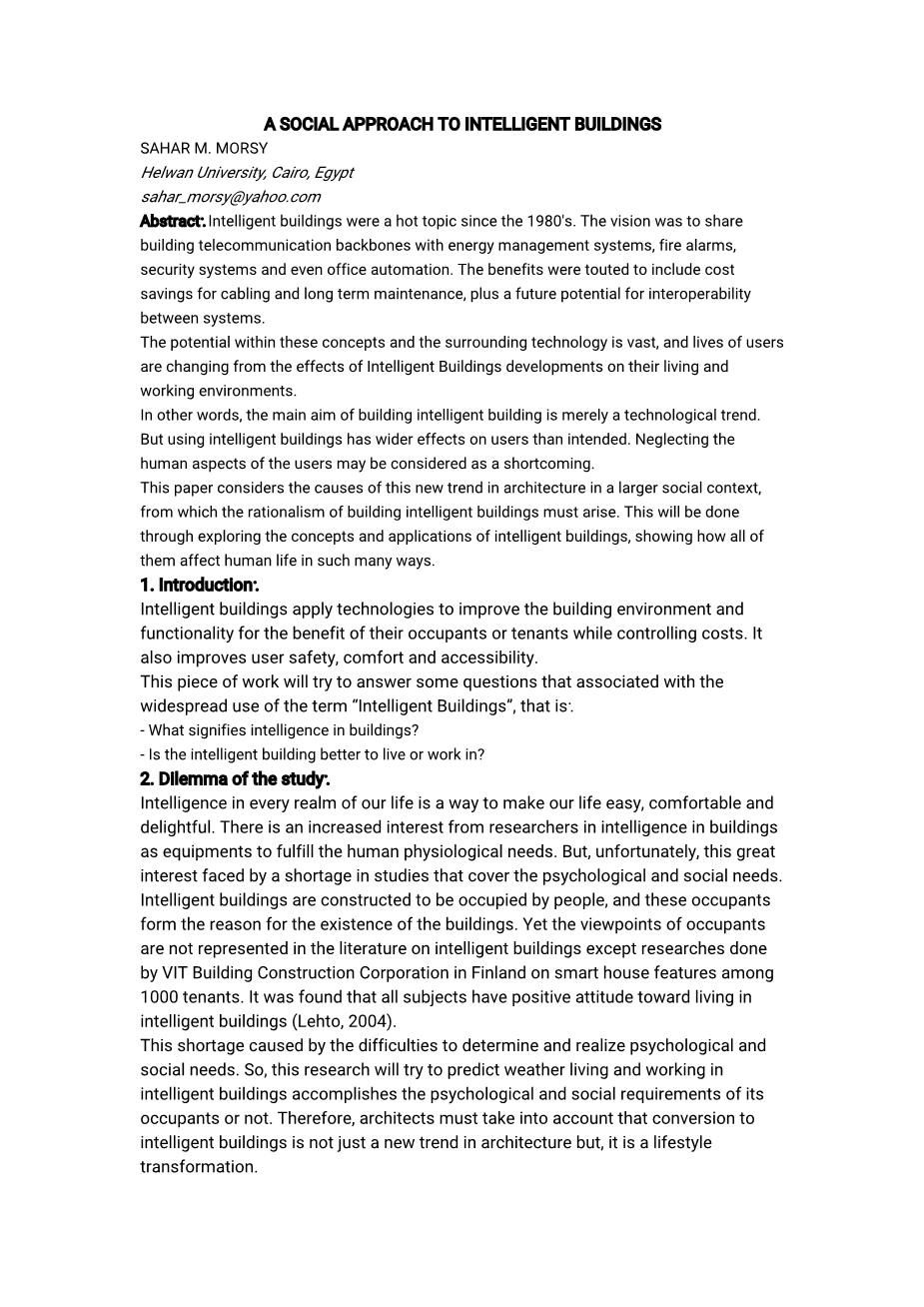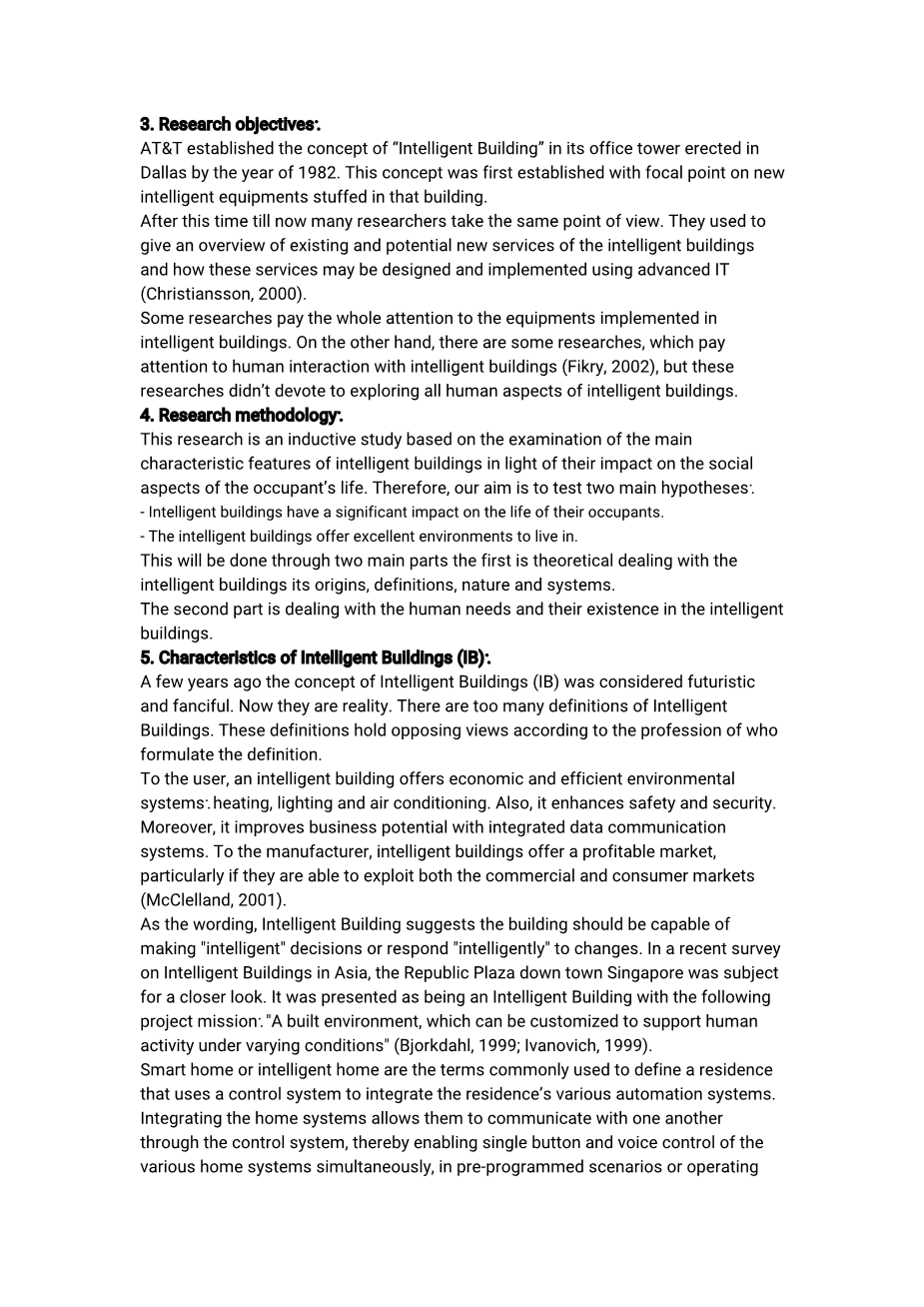

英语原文共 7 页,剩余内容已隐藏,支付完成后下载完整资料
A SOCIAL APPROACH TO INTELLIGENT BUILDINGS
SAHAR M. MORSY
Helwan University, Cairo, Egypt
sahar_morsy@yahoo.com
Abstract: Intelligent buildings were a hot topic since the 1980#39;s. The vision was to share building telecommunication backbones with energy management systems, fire alarms, security systems and even office automation. The benefits were touted to include cost savings for cabling and long term maintenance, plus a future potential for interoperability between systems.
The potential within these concepts and the surrounding technology is vast, and lives of users are changing from the effects of Intelligent Buildings developments on their living and working environments.
In other words, the main aim of building intelligent building is merely a technological trend. But using intelligent buildings has wider effects on users than intended. Neglecting the human aspects of the users may be considered as a shortcoming.
This paper considers the causes of this new trend in architecture in a larger social context, from which the rationalism of building intelligent buildings must arise. This will be done through exploring the concepts and applications of intelligent buildings, showing how all of them affect human life in such many ways.
1. Introduction:
Intelligent buildings apply technologies to improve the building environment and functionality for the benefit of their occupants or tenants while controlling costs. It also improves user safety, comfort and accessibility.
This piece of work will try to answer some questions that associated with the widespread use of the term “Intelligent Buildings”, that is:
- What signifies intelligence in buildings?
- Is the intelligent building better to live or work in?
2. Dilemma of the study:
Intelligence in every realm of our life is a way to make our life easy, comfortable and delightful. There is an increased interest from researchers in intelligence in buildings as equipments to fulfill the human physiological needs. But, unfortunately, this great interest faced by a shortage in studies that cover the psychological and social needs.
Intelligent buildings are constructed to be occupied by people, and these occupants form the reason for the existence of the buildings. Yet the viewpoints of occupants are not represented in the literature on intelligent buildings except researches done by VIT Building Construction Corporation in Finland on smart house features among 1000 tenants. It was found that all subjects have positive attitude toward living in intelligent buildings (Lehto, 2004).
This shortage caused by the difficulties to determine and realize psychological and social needs. So, this research will try to predict weather living and working in intelligent buildings accomplishes the psychological and social requirements of its occupants or not. Therefore, architects must take into account that conversion to intelligent buildings is not just a new trend in architecture but, it is a lifestyle transformation.
3. Research objectives:
ATamp;T established the concept of “Intelligent Building” in its office tower erected in Dallas by the year of 1982. This concept was first established with focal point on new intelligent equipments stuffed in that building.
After this time till now many researchers take the same point of view. They used to give an overview of existing and potential new services of the intelligent buildings and how these services may be designed and implemented using advanced IT (Christiansson, 2000).
Some researches pay the whole attention to the equipments implemented in intelligent buildings. On the other hand, there are some researches, which pay attention to human interaction with intelligent buildings (Fikry, 2002), but these researches didnrsquo;t devote to exploring all human aspects of intelligent buildings.
4. Research methodology:
This research is an inductive study based on the examination of the main characteristic features of intelligent buildings in light of their impact on the social aspects of the occupantrsquo;s life. Therefore, our aim is to test two main hypotheses:
- Intelligent buildings have a significant impact on the life of their occupants.
- The intelligent buildings offer excellent environments to live in.
This will be done through two main parts the first is theoretical dealing with the intelligent buildings its origins, definitions, nature and systems.
The second part is dealing with the human needs and their existence in the intelligent buildings.
5. Characteristics of Intelligent Buildings (IB):
A few years ago the concept of Intelligent Buildings (IB) was considered futuristic and fanciful. Now they are reality. There are too many definitions of Intelligent Buildings. These definitions hold opposing views according to the profession of who formulate the definition.
To the user, an intelligent building offers economic and efficient environmental systems: heating, lighting and air conditioning. Also, it enhances safety and security. Moreover, it improves business potential with integrated data communication systems. To the manufacturer, intelligent buildings offer a profitable market, particularly if they are able to exploit both the commercial and consumer markets (McClelland, 2001).
As the wording, Intelligent Building suggests the building should be capable of making 'intelligent' decisions or respond 'intelligently' to changes. In a recent survey on Intelligent Buildings in Asia, the Republic Plaza down town Singapore was subject for a closer look. It was presented as being an Intelligent Building with the following project mission: 'A built environment, which can be customized to support human activi
剩余内容已隐藏,支付完成后下载完整资料
资料编号:[485663],资料为PDF文档或Word文档,PDF文档可免费转换为Word


